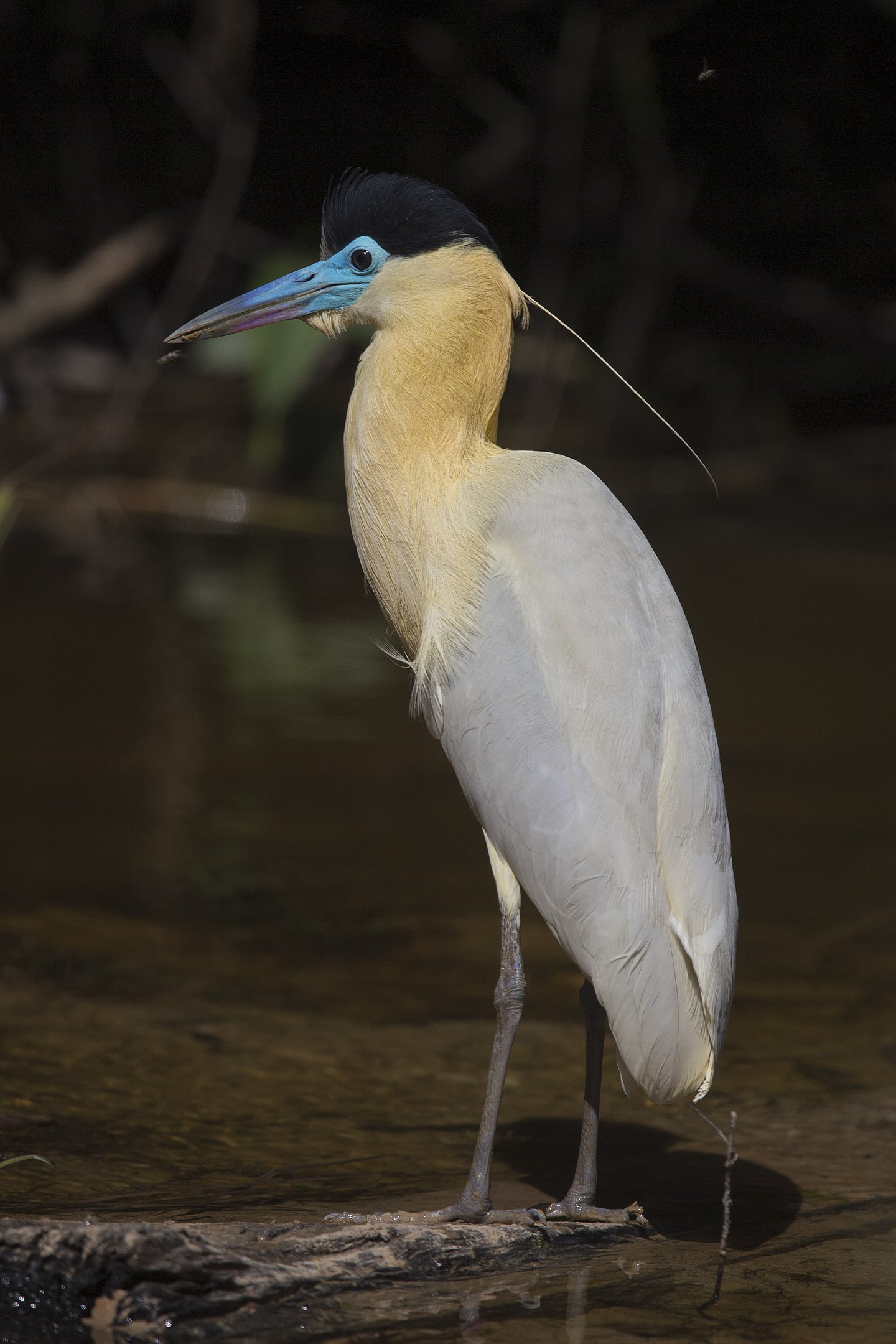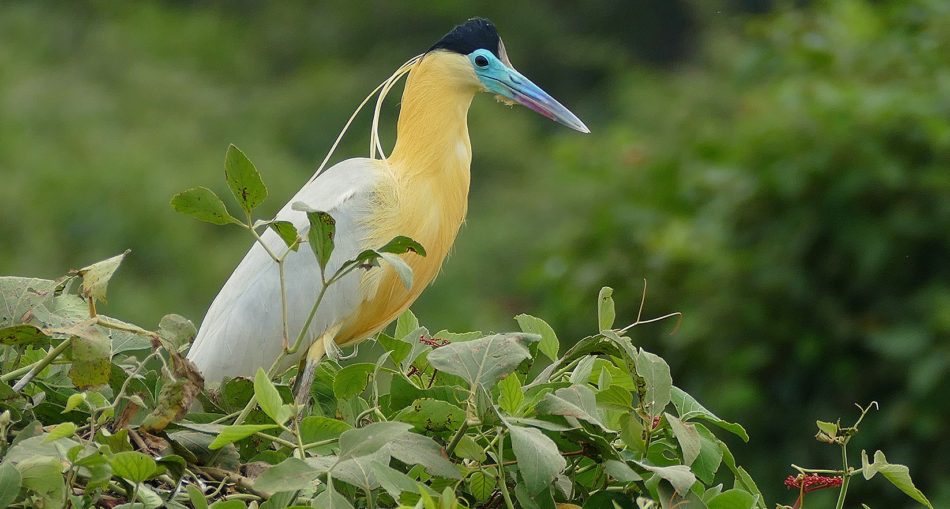One of the most unique herons of the Neotropics! The Capped Heron (Pilherodius pileatus) truly stands out on its own, as no other combines a brilliant sky-blue face and bill with a black crown. It is the only species of the Pilherodius genus, and one of the least known of the heron family Ardeidae. It is superficially similar to the group of the night herons, but is active during daytime or at twilight. They are usually found feeding alone at steams, creeks or in puddles on small fish, aquatic insects and frogs. The Capped Heron in Spanish is called “Garciola”.

The capped heron (Pilherodius pileatus) | By Andreas Trepte – Own work, CC BY-SA 4.0, https://commons.wikimedia.org/w/index.php?curid=42850093
Scientific Classification Of The Capped Heron
- Kingdom: Animalia
- Phylum: Chordata
- Class: Aves
- Order: Pelecaniformes
- Family: Ardeidae
- Genus: PilherodiusL. Reichenbach, 1853
- Species: P. pileatus
Description Of The Capped Heron
BIOMETRICS:
- Length: 50-60 cm
- Weight: 500-550 g
Adult – The base colour of the Capped Heron is white, setting off the distinctive black crown. The bill, also distinctive, is predominantly blue-grey, reddish in the centre, tipped in grey or yellow. The forehead is white or grey and bright blue. The iris is yellow, green-brown, to brown. The distinctive slender white head plumes may be as long as 20 cm. On the back and wings, it is a pearl to pale white with grey shading. The relatively thick (for a heron) neck has a variable amount of cream colour. The legs are blue-grey, with somewhat darker toes.
Juvenile – The fledgeling’s plumage is white like the adult, but it has a streaked crown and is paler grey on the wings. Juveniles retain some white and grey variegation on the head and have greyer wings than adults. Younger juveniles lack head plumes but do develop them while in juvenile plumage.
Chick – Chick has white down.
Where Does The Capped Heron Live?
Capped Herons are exclusively neotropical, predominantly Amazonian, extending into northern and south-central South America – (Bolivia, Brazil, Colombia, Ecuador, French Guiana, Guyana, Panama, Paraguay, Peru, Suriname, Venezuela). It is found in the lowlands and upland rain forests below 900 m.
Diet Of The Capped Heron
Like other herons, the Capped Heron feeds mainly on fish, but very small fish less than 5 cm long. It also catches aquatic insects and amphibians. It feeds by day, standing motionless in shallow water, or walking slowly along the water edge in ponds, streams and pools. The prey is caught with the bill, sometimes impaled by jabbing. Capped Heron usually feeds alone, but it may occasionally feed with other herons’ species in a loose group.
Behaviour Of The Capped Heron
They are strongly territorial, so much so that the same bird may be seen at the same foraging site for weeks at a time. The heron turns the head from side to side, watching for prey. Then, it crouches very slowly and holds the neck to catch the fish. It frequently moves, flying off 100 meters or so to a new feeding area. This species is wary and quick to flush. It may be seen in small groups of up to 12 birds in swampy wooded areas, and they may roost in open bare trees. Capped Heron performs some displays high in a bare tree, stretching up the neck with fluffed feathers, and bowing several times while uttering soft “Ca-huu, Ca-huu, Ca-huu…” rising in the middle and descending at the end. Capped Heron flies with shallow wing beats, with retracted head and the long legs held beyond the tail. The flight may appear heavy, but it is powerful
Call / Communication Of The Capped Heron
These birds are usually quiet. Their calls are described as muffled hoots. A “woop-woop-woop” is given as the bird lowers its head and opens its nuchal crest in front of its mate. They also may make guttural croaks.
Reproduction Of The Capped Heron
The nesting behaviour of the Capped Heron is poorly known. The nest is built relatively low in the tree. It is typically made with sticks. The clutch is two to four eggs. Incubation lasts about 26-27 days. Chicks are covered in white down and fed by both parents.
Protection / Threat / Status Of The Capped Heron
Capped Heron is uncommon, even scarce in the wide distribution. It is resident in the wet and freshwater habitats, but they are in low density. This species is poorly known, but not threatened at this moment.
Watch This: The Capped Heron
About Capped Heron
As you would have read at the beginning of the article – the capped heron is one of the most unique herons of the neotropics (Guyana). It is a passive feeder, primarily on fish and aquatic insects usually seen Standing still or Walking carefully along its chosen bank. However, little is known about nesting or parental care of this species of heron.
Article References:
- https://en.wikipedia.org/wiki/Capped_heron
- https://neotropical.birds.cornell.edu/Species-Account/nb/species/capher1/distribution
- http://www.oiseaux-birds.com/card-capped-heron.html
- https://www.canopytower.com/capped-heron/
- https://www.heronconservation.org/herons-of-the-world/list-of-herons/capped-heron
- Main Image: The Capped Heron (Pilherodius pileatus) | By Bernard DUPONT from FRANCE – Capped Heron (Pilherodius pileatus), CC BY-SA 2.0, https://commons.wikimedia.org/w/index.php?curid=49981157
Discover more from Things Guyana
Subscribe to get the latest posts sent to your email.







